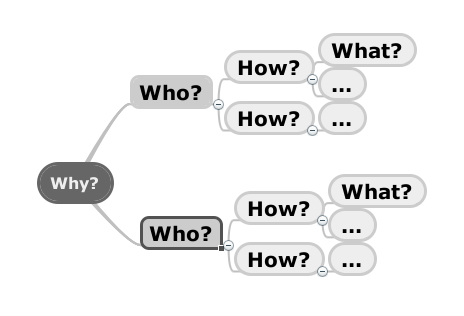Impact Mapping
Impact mapping (also called Effect Mapping) is a strategic planning technique. It prevents organisations from getting lost while building products and delivering projects, by clearly communicating assumptions, helping teams align their activities with overall business objectives and make better roadmap decisions.
Our products and projects do not work in a vacuum. They have an interdependent, dynamic relationship with people, other projects, the organisation and the wider community around them. Yet currently popular planning methods either expect the world to stand still while we deliver or give up on creating any kind of long-term big-picture view, leaving a huge communication gap between business sponsors and delivery teams. Impact maps visualise the dynamic relationship between delivery plans and the world around them, capturing the most important assumptions as well as delivery scope. They help us adapt plans effectively and react to change, while still providing a good road map for delivery teams and a big-picture view for business sponsors.
Impact mapping helps to reduce waste by preventing scope creep and over-engineered solutions. It provides focus for delivery by putting deliverables in the context of impacts they are supposed to achieve. It enhances collaboration by creating a big-picture view that business sponsors and delivery teams can use for better prioritisation and as a reference for more meaningful progress monitoring and reporting. Finally, it helps to ensure that the right business outcomes are achieved, or that unrealistic projects are stopped before they cost too much, by clearly communicating underlying assumptions and allowing teams to test them.
An impact map is a visualisation of scope and underlying assumptions, created collaboratively by senior technical and business people. It is a mind-map grown during a discussion facilitated by answering the following four questions:
- Why?: The centre of an impact map answers the most important question: Why are we doing this? This is the goal we are trying to achieve.
- Who?: The first branch of an impact map provides answers to the following questions: Who can produce the desired effect? Who can obstruct it? Who are the consumers or users of our product? Who will be impacted by it? These are the actors who can influence the outcome.
- How?: The second branch level of an impact map sets the actors in the perspective of our business goal. It answers the following questions: How should our actors’ behaviour change? How can they help us to achieve the goal? How can they obstruct or prevent us from succeeding? These are the impacts that we’re trying to create.
- What?: Once we have the first three questions answered, we can talk about scope. The third branch level of an impact map answers the following question: What can we do, as an organisation or a delivery team, to support the required impacts? These are the deliverables, software features and organisational activities.

Project plans and requirements documents are often shopping lists of features, without any context why such things are important. Without a clear mapping of deliverables to business objectives, and a justification of that mapping through impacts that need to be supported, it is incredibly difficult to argue why certain items should or shouldn’t be invested in. In larger organisations with many project stakeholders or product sponsors, this leads to huge scope-creep as everyone’s pet features and ideas are bundled in.
An impact map puts all the deliverables in the context of the impacts that they are supposed to support. This allows us to compare deliverables and avoid over-investing in less important areas of a system. It also helps to throw out deliverables that do not really contribute to any impact that is critical for a particular goal. Finally, by connecting deliverables to impacts and goals, an impact map shows the chain of reasoning that led to a feature suggestion. This allows us to scrutinise those decisions better and re-evaluate them as new information becomes available through delivery.
##Further reading
Here are some good resources on impact mapping:
- The Impact Mapping book by Gojko Adzic
- A detailed description of impact mapping, with an example, at impactmapping.org
- Talks and videos about impact mapping
##How we can help you?
You can count on us for facilitation, helping senior stakeholders prepare for impact mapping sessions and making sure that the discussion is as productive as possible.
We can also educate your team to facilitate impact mapping sessions and scale this process across a larger group
##Why us?
Gojko is one of the thought-leaders in the field. As an early adopter of the technique, he helped organisations from online gaming platfoms to retail banking giants apply the method, and has helped bring the practice into modern iterative delivery. He is the author of the Impact Mapping book.